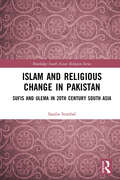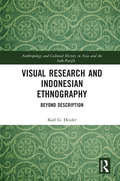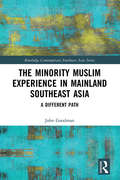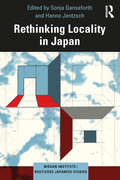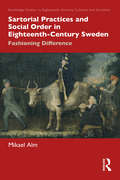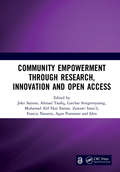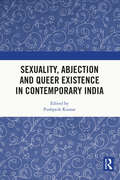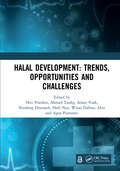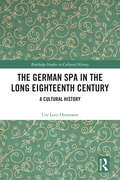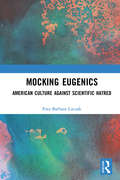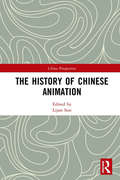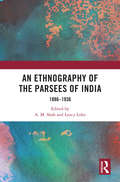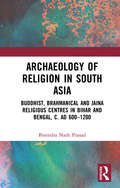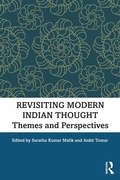- Table View
- List View
Islam and Religious Change in Pakistan: Sufis and Ulema in 20th Century South Asia (Routledge South Asian Religion Series)
by Saadia SumbalThis book examines the history of, and the contestations on, Islam and the nature of religious change in 20th century Pakistan, focusing in particular on movements of Islamic reform and revival. This book is the first to bring the different facets of Islam, particularly Islamic reformism and shrine-oriented traditions, together within the confines of a single study ranging from the colonial to post-colonial era. Using a rich corpus of Urdu and Arabic material including biographical accounts, Sufi discourses (malfuzat), letter collections, polemics and unexplored archival sources, the author investigates how Islamic reformism and shrine-oriented religiosity interacted with one another in the post-colonial state of Pakistan. Focusing on the district of Mianwali in Pakistani northwestern Punjab, the book demonstrates how reformist ideas could only effectively find space to permeate after accommodating Sufi thoughts and practices; the text-based religious identity coalesced with overlapped traditional religious rituals and practices. The book proceeds to show how reformist Islam became the principal determinant of Islamic identity in the post-colonial state of Pakistan and how one of its defining effects was the hardening of religious boundaries. Challenging the approach of viewing the contestation between reformist and shrine-oriented Islam through the lens of binaries modern/traditional and moderate/extremist, this book makes an important contribution to the field of South Asian religion and Islam in modern South Asia.
Visual Research and Indonesian Ethnography: Beyond Description (Anthropology and Cultural History in Asia and the Indo-Pacific)
by Karl HeiderThis book focuses on how visual records – mainly on film or video – can provide data for research and presents a variety of visual projects drawn from ethnographic fieldwork in Indonesia. Karl Heider argues for the expansion of visual anthropology - or anthropology with a camera - beyond descriptive ethnographic film into actual use of the camera as a research tool. The chapters explore several ways in which camera-generated materials can complement and support what anthropologists already do in their research. Heider includes samples from fieldwork in Indonesia conducted over a number of years, particularly in New Guinea and Sumatra with groups including the Dani and Minangkabau. His studies combine visual and psychological anthropology and provides insight into the analysis of emotions in particular. Intended to inspire new approaches to the ethnographic enterprise, the book is valuable for scholars of visual anthropology and Southeast Asia.
Visual Research and Indonesian Ethnography: Beyond Description (Anthropology and Cultural History in Asia and the Indo-Pacific)
by Karl HeiderThis book focuses on how visual records – mainly on film or video – can provide data for research and presents a variety of visual projects drawn from ethnographic fieldwork in Indonesia. Karl Heider argues for the expansion of visual anthropology - or anthropology with a camera - beyond descriptive ethnographic film into actual use of the camera as a research tool. The chapters explore several ways in which camera-generated materials can complement and support what anthropologists already do in their research. Heider includes samples from fieldwork in Indonesia conducted over a number of years, particularly in New Guinea and Sumatra with groups including the Dani and Minangkabau. His studies combine visual and psychological anthropology and provides insight into the analysis of emotions in particular. Intended to inspire new approaches to the ethnographic enterprise, the book is valuable for scholars of visual anthropology and Southeast Asia.
The Minority Muslim Experience in Mainland Southeast Asia: A Different Path (Routledge Contemporary Southeast Asia Series)
by John GoodmanThis book examines the lives of the Malay and Cham Muslims in Thailand, Cambodia and Vietnam and examines how they co-exist and live in societies that are dominated by an alternative consensus and are illiberal and non-democratic in nature. Focusing on two major Muslim communities in Southeast Asia, both of whom live as minorities in societies that are not democratic and have a history of hostility and repression towards non-conforming ideas, the book explains their circumstances, the choices and life decisions they have to make, and how minorities can thrive in an unfriendly, monocultural environment. Based on original field work and research, the author analyses how people live, and how they adapt to societies which are not motivated by Western liberal ideals of multiculturalism. The book also offers a unique perspective on how Islam develops in an environment where it is seen as alien and disloyal. A useful contribution analyzing historical and post-colonial experiences of Muslim minorities and how they survive and evolve over the course of state monopoly in mainland Southeast Asia, this book will be of interest to academics working on Muslim minorities, Asian Religion and Southeast Asian Studies.
The Minority Muslim Experience in Mainland Southeast Asia: A Different Path (Routledge Contemporary Southeast Asia Series)
by John GoodmanThis book examines the lives of the Malay and Cham Muslims in Thailand, Cambodia and Vietnam and examines how they co-exist and live in societies that are dominated by an alternative consensus and are illiberal and non-democratic in nature. Focusing on two major Muslim communities in Southeast Asia, both of whom live as minorities in societies that are not democratic and have a history of hostility and repression towards non-conforming ideas, the book explains their circumstances, the choices and life decisions they have to make, and how minorities can thrive in an unfriendly, monocultural environment. Based on original field work and research, the author analyses how people live, and how they adapt to societies which are not motivated by Western liberal ideals of multiculturalism. The book also offers a unique perspective on how Islam develops in an environment where it is seen as alien and disloyal. A useful contribution analyzing historical and post-colonial experiences of Muslim minorities and how they survive and evolve over the course of state monopoly in mainland Southeast Asia, this book will be of interest to academics working on Muslim minorities, Asian Religion and Southeast Asian Studies.
Rethinking Locality in Japan (Nissan Institute/Routledge Japanese Studies)
by Sonja Ganseforth Hanno JentzschThis book inquires what is meant when we say "local" and what "local" means in the Japanese context. Through the window of locality, it enhances an understanding of broader political and socio-economic shifts in Japan. This includes demographic change, electoral and administrative reform, rural decline and revitalization, welfare reform, as well as the growing metabolic rift in energy and food production. Chapters throughout this edited volume discuss the different and often contested ways in which locality in Japan has been reconstituted, from historical and contemporary instances of administrative restructuring, to more subtle social processes of making – and unmaking – local places. Contributions from multiple disciplinary perspectives are included to investigate the tensions between overlapping and often incongruent dimensions of locality. Framed by a theoretical discussion of socio-spatial thinking, such issues surrounding the construction and renegotiation of local places are not only relevant for Japan specialists, but also connected with topical scholarly debates further afield. Accordingly, Rethinking Locality in Japan will appeal to students and scholars from Japanese studies and human geography to anthropology, history, sociology and political science.
Rethinking Locality in Japan (Nissan Institute/Routledge Japanese Studies)
by Sonja GanseforthThis book inquires what is meant when we say "local" and what "local" means in the Japanese context. Through the window of locality, it enhances an understanding of broader political and socio-economic shifts in Japan. This includes demographic change, electoral and administrative reform, rural decline and revitalization, welfare reform, as well as the growing metabolic rift in energy and food production. Chapters throughout this edited volume discuss the different and often contested ways in which locality in Japan has been reconstituted, from historical and contemporary instances of administrative restructuring, to more subtle social processes of making – and unmaking – local places. Contributions from multiple disciplinary perspectives are included to investigate the tensions between overlapping and often incongruent dimensions of locality. Framed by a theoretical discussion of socio-spatial thinking, such issues surrounding the construction and renegotiation of local places are not only relevant for Japan specialists, but also connected with topical scholarly debates further afield. Accordingly, Rethinking Locality in Japan will appeal to students and scholars from Japanese studies and human geography to anthropology, history, sociology and political science.
Sartorial Practices and Social Order in Eighteenth-Century Sweden: Fashioning Difference (Routledge Studies in Eighteenth-Century Cultures and Societies)
by Mikael AlmThe interplay between clothes and social order in early modern societies is well known. Differences in dress and hierarchies of appearances coincided with and structured social hierarchies and notions of difference. However, clothes did not merely reproduce set social patterns. They were agents of change, actively used by individuals and groups to make claims and transgress formal boundaries. This was not least the case for the revolutionary decades of the late eighteenth century, the period in focus of this book. Unlike previous studies on sumptuary laws and other legal actions taken by governments and formal power holders, this book offers a broader and more everyday perspective on late eighteenth-century sartorial discourse. In 1773, there was a publicly announced prize competition on the advantages and disadvantages of a national dress in Sweden. Departing from the submitted replies, the study opens a window onto the sartorial world. Several fields of cultural history are brought together: social culture in terms of order, hierarchies, and notions of difference; sartorial culture with contemporary views on dress and moral aspects of sartorial practices; and visual culture in terms of sartorial means of making a difference and the emphasis on the necessity of a legible social order.
Sartorial Practices and Social Order in Eighteenth-Century Sweden: Fashioning Difference (Routledge Studies in Eighteenth-Century Cultures and Societies)
by Mikael AlmThe interplay between clothes and social order in early modern societies is well known. Differences in dress and hierarchies of appearances coincided with and structured social hierarchies and notions of difference. However, clothes did not merely reproduce set social patterns. They were agents of change, actively used by individuals and groups to make claims and transgress formal boundaries. This was not least the case for the revolutionary decades of the late eighteenth century, the period in focus of this book. Unlike previous studies on sumptuary laws and other legal actions taken by governments and formal power holders, this book offers a broader and more everyday perspective on late eighteenth-century sartorial discourse. In 1773, there was a publicly announced prize competition on the advantages and disadvantages of a national dress in Sweden. Departing from the submitted replies, the study opens a window onto the sartorial world. Several fields of cultural history are brought together: social culture in terms of order, hierarchies, and notions of difference; sartorial culture with contemporary views on dress and moral aspects of sartorial practices; and visual culture in terms of sartorial means of making a difference and the emphasis on the necessity of a legible social order.
Community Empowerment through Research, Innovation and Open Access: Proceedings of the 3rd International Conference on Humanities and Social Sciences (ICHSS 2020), Malang, Indonesia, 28 October 2020
by Joko Sayono Ahmad Taufiq Luechai Sringernyuang Francis M. Navarro Agus Purnomo Idris Muhamad Alif Haji Sismat Zawawi Isma'IlICHSS is an international seminar that is held every two years organized by the Research and Community Service Institute of the State University of Malang. The meeting aims to discuss the theoretical and practical developments of Social Sciences and Humanities in Indonesia and other countries with a view to build academic networks by gathering academics from various research institutes and universities.Community empowerment serves as a trigger to increase community independence and to cope with the challenges resulting from the rapid development of technology. An important aspect of the community empowerment effort is to link the results of innovation research for the benefit of community. The results of research should not only be limited to publications in the academic environment. Open Access to various forms of the existing literature is one of the requirements for innovative research to develop optimally. Therefore, this seminar has also served as a place for field researchers from various geographical areas to socialize, to discuss and to find solutions to current issues in the field of social sciences and humanities, as well as to build cooperation and synergy in creating ideas for mutual collaboration and to create joint research.
Community Empowerment through Research, Innovation and Open Access: Proceedings of the 3rd International Conference on Humanities and Social Sciences (ICHSS 2020), Malang, Indonesia, 28 October 2020
by Joko SayonoICHSS is an international seminar that is held every two years organized by the Research and Community Service Institute of the State University of Malang. The meeting aims to discuss the theoretical and practical developments of Social Sciences and Humanities in Indonesia and other countries with a view to build academic networks by gathering academics from various research institutes and universities.Community empowerment serves as a trigger to increase community independence and to cope with the challenges resulting from the rapid development of technology. An important aspect of the community empowerment effort is to link the results of innovation research for the benefit of community. The results of research should not only be limited to publications in the academic environment. Open Access to various forms of the existing literature is one of the requirements for innovative research to develop optimally. Therefore, this seminar has also served as a place for field researchers from various geographical areas to socialize, to discuss and to find solutions to current issues in the field of social sciences and humanities, as well as to build cooperation and synergy in creating ideas for mutual collaboration and to create joint research.
Sexuality, Abjection and Queer Existence in Contemporary India
by Pushpesh KumarThis volume explores existing and emerging sexual cultures of contemporary India and the predicaments faced by abjected and sexual marginalities. It traces the sexual politics within popular culture, literary genres, advertisement, consumerism, globalizing cities, social movements, law, scientific research, the hijra community life, (alternative) families and kinship, and sites that define the cultural other whose sexual practices or identities fall beyond normative moral conventions. The chapters examine a range of connected sociological and political issues including questions of agency, judgments around intimate sexual relationships, the role of the state, popular understandings of adolescent romance, notion of legitimacy and stigma, moral policing and resistance, body politics and marginality, representations in popular and folk culture, sexual violence and freedom, problems with historiography, structural inequalities, queer erotica, gay consumerism, hijra suicides, and marriage and divorce. The volume also proposes certain transformative possibilities towards envisioning and (re)scripting sexual equalities. This interdisciplinary book will be important for those interested in sexuality studies, queer studies, gender studies, cultural studies, sociology, law, history, literature and Global South studies as well as policymakers, civil society activists and nongovernmental organizations working in the area.
Sexuality, Abjection and Queer Existence in Contemporary India
by Pushpesh KumarThis volume explores existing and emerging sexual cultures of contemporary India and the predicaments faced by abjected and sexual marginalities. It traces the sexual politics within popular culture, literary genres, advertisement, consumerism, globalizing cities, social movements, law, scientific research, the hijra community life, (alternative) families and kinship, and sites that define the cultural other whose sexual practices or identities fall beyond normative moral conventions. The chapters examine a range of connected sociological and political issues including questions of agency, judgments around intimate sexual relationships, the role of the state, popular understandings of adolescent romance, notion of legitimacy and stigma, moral policing and resistance, body politics and marginality, representations in popular and folk culture, sexual violence and freedom, problems with historiography, structural inequalities, queer erotica, gay consumerism, hijra suicides, and marriage and divorce. The volume also proposes certain transformative possibilities towards envisioning and (re)scripting sexual equalities. This interdisciplinary book will be important for those interested in sexuality studies, queer studies, gender studies, cultural studies, sociology, law, history, literature and Global South studies as well as policymakers, civil society activists and nongovernmental organizations working in the area.
Halal Development: Proceedings of the 1st International Conference on Halal Development (ICHaD 2020), Malang, Indonesia, October 8, 2020
by Heri Pratikto Ahmad Taufiq Adam Voak Nurdeng Deuraseh Hadi Nur Winai Dahlan M. M S. S Idris S. S, M. M S. S Idris S Agus PurnomoThe increasing demand for halal products, including goods and services, every year, especially for food and beverages, has resulted in a growing need for products with halal guarantees. Along with the increasing trend of the global demand, it has resulted in an increase in producers of halal food and beverages in both Muslim and non-Muslim countries. In addition the demand for halal tourism is also increasing. Indonesia is one of the largest Muslim countries in the world. However, there are still many Muslim consumer actors and Muslim producer actors who do not yet have an awareness of the importance of complying with the provisions of Islamic law in consuming and producing goods and services. There are still many restaurants and hotels that serve food and drinks that are not certified halal. There are still many food, medicinal and cosmetic products that are not halal certified. But now many secular countries such as France, Canada, Australia, the United States, Britain are also halal certified with the aim of meeting the Muslim demand for halal products for food and beverage, including for halal tourism. Starting from the development of the halal industry both in the fields of food, beverages and services, an International Seminar was held, which provides a more complete understanding of halal products, current halal developments and can serve as motivation to produce halal products, providing research results from the topic of halal development. The international seminar, entitled International Conference on Halal Development, listed speakers from several countries able to provide an overview of the halal development of several countries. This book contains a selection of papers from the conference.
Halal Development: Proceedings of the 1st International Conference on Halal Development (ICHaD 2020), Malang, Indonesia, October 8, 2020
by Heri PratiktoThe increasing demand for halal products, including goods and services, every year, especially for food and beverages, has resulted in a growing need for products with halal guarantees. Along with the increasing trend of the global demand, it has resulted in an increase in producers of halal food and beverages in both Muslim and non-Muslim countries. In addition the demand for halal tourism is also increasing. Indonesia is one of the largest Muslim countries in the world. However, there are still many Muslim consumer actors and Muslim producer actors who do not yet have an awareness of the importance of complying with the provisions of Islamic law in consuming and producing goods and services. There are still many restaurants and hotels that serve food and drinks that are not certified halal. There are still many food, medicinal and cosmetic products that are not halal certified. But now many secular countries such as France, Canada, Australia, the United States, Britain are also halal certified with the aim of meeting the Muslim demand for halal products for food and beverage, including for halal tourism. Starting from the development of the halal industry both in the fields of food, beverages and services, an International Seminar was held, which provides a more complete understanding of halal products, current halal developments and can serve as motivation to produce halal products, providing research results from the topic of halal development. The international seminar, entitled International Conference on Halal Development, listed speakers from several countries able to provide an overview of the halal development of several countries. This book contains a selection of papers from the conference.
The German Spa in the Long Eighteenth Century: A Cultural History (Routledge Studies in Cultural History #107)
by Ute Lotz-HeumannShifting the focus from the medical use of spas to their cultural and social functions, this study shows that eighteenth- and early nineteenth-century German spas served a vital role as spaces where new ways of perceiving the natural environment and conceptualizing society were disseminated. Although spas continued to be places of health and healing, their function and perception in Central Europe changed fundamentally around the middle of the eighteenth century. This transformation of the role of the spa occurred in two ways. First, the spa popularized a new perception of the landscape with a preference for mountains and the seacoast, forming the basis for the cultural assumptions underlying modern tourism. Second, contemporaries perceived spas as meeting places comparable to institutions of Enlightenment sociability like coffeehouses, salons, and Masonic lodges. Spas were conceived as spaces where the nobility and the bourgeoisie could interact on an equal footing, thereby overcoming the constraints of early modern social boundaries. These changes were negotiated through both personal interactions at spas and an increasingly sophisticated published spa discourse. The late eighteenth- and early nineteenth-century German spa thus helped to bring about social and cultural modernity.
The German Spa in the Long Eighteenth Century: A Cultural History (Routledge Studies in Cultural History #107)
by Ute Lotz-HeumannShifting the focus from the medical use of spas to their cultural and social functions, this study shows that eighteenth- and early nineteenth-century German spas served a vital role as spaces where new ways of perceiving the natural environment and conceptualizing society were disseminated. Although spas continued to be places of health and healing, their function and perception in Central Europe changed fundamentally around the middle of the eighteenth century. This transformation of the role of the spa occurred in two ways. First, the spa popularized a new perception of the landscape with a preference for mountains and the seacoast, forming the basis for the cultural assumptions underlying modern tourism. Second, contemporaries perceived spas as meeting places comparable to institutions of Enlightenment sociability like coffeehouses, salons, and Masonic lodges. Spas were conceived as spaces where the nobility and the bourgeoisie could interact on an equal footing, thereby overcoming the constraints of early modern social boundaries. These changes were negotiated through both personal interactions at spas and an increasingly sophisticated published spa discourse. The late eighteenth- and early nineteenth-century German spa thus helped to bring about social and cultural modernity.
Mocking Eugenics: American Culture against Scientific Hatred
by Ewa Barbara LuczakMocking Eugenics explores the opposition to eugenic discourse mounted by twentieth-century American artists seeking to challenge and destabilize what they viewed as a dangerous body of thought. Focusing on their wielding of humor to attack the contemporaneous science of heredity and the totalitarian impulse informing it, this book confronts the conflict between eugenic theories presented as grounded in scientific and metaphysical truth and the satirical treatment of eugenics as not only absurdly illogical but also antithetical to democratic ideals and inimical to humanistic values. Through analyses of the films of Charlie Chaplin and the fiction of F. Scott Fitzgerald, Ernest Hemingway, Anita Loos, and Wallace Thurman, Mocking Eugenics examines their use of laughter to dismantle the rhetoric of perfectionism, white supremacy, and nativism that shaped mainstream expressions of American patriotism and normative white masculinity. As such, it will appeal to scholars of cultural studies, literature, cinema, sociology, humor, and American studies.
Mocking Eugenics: American Culture against Scientific Hatred
by Ewa Barbara LuczakMocking Eugenics explores the opposition to eugenic discourse mounted by twentieth-century American artists seeking to challenge and destabilize what they viewed as a dangerous body of thought. Focusing on their wielding of humor to attack the contemporaneous science of heredity and the totalitarian impulse informing it, this book confronts the conflict between eugenic theories presented as grounded in scientific and metaphysical truth and the satirical treatment of eugenics as not only absurdly illogical but also antithetical to democratic ideals and inimical to humanistic values. Through analyses of the films of Charlie Chaplin and the fiction of F. Scott Fitzgerald, Ernest Hemingway, Anita Loos, and Wallace Thurman, Mocking Eugenics examines their use of laughter to dismantle the rhetoric of perfectionism, white supremacy, and nativism that shaped mainstream expressions of American patriotism and normative white masculinity. As such, it will appeal to scholars of cultural studies, literature, cinema, sociology, humor, and American studies.
The History of Chinese Animation (China Perspectives)
China has been one of the first countries to develop its own aesthetic for dynamic images and to create animation films with distinctive characteristics. In recent years, however, and subject to the influence of Western and Japanese animation, the Chinese animation industry has experienced several new stages of development, prompting the question as to where animation in China is heading in the future. This book describes the history, present and future of China’s animation industry. The author divides the business’s 95-year history into six periods and analyses each of these from an historical, aesthetic, and artistic perspective. In addition, the book focuses on representative works; themes; directions; artistic styles; techniques; industrial development; government support policies; business models; the nurturing of education and talent; broadcasting systems and animation. Scholars and students who are interested in the history of Chinese animation will benefit from this book and it will appeal additionally to readers interested in Chinese film studies.
An Ethnography of the Parsees of India: 1886–1936
by A. M. Shah Lancy LoboThis volume explores a wide spectrum of Parsee culture and society derived through essays from the Journal of Anthropological Society of Bombay (1886–1936). This journal documents intensive scholarship on the Parsee community by eminent anthropologists, Indologists, orientalogists, historians, linguists, and administrators in the late 18th and early 19th centuries. Comprising 0.05% of India’s total population today, the Parsees (now spelled “Parsis”) have made significant contributions to modern India. Through contributions of Jivanji Jamshedji Modi, Bomanjee Byramjee Patell, and Rustamji Munshi, eminent Parsee scholars, the essays in this book discuss the social and cultural frameworks which constitute various key phases in the Parsee life nearly 100 years ago. They also focus on themes such as birth, childhood and initiation, marriage, and death. The volume also features works on Parsee folklore and oral literature. An important contribution to Parsi culture and living, this book will be of great interest to scholars and researchers of sociology, social anthropology, ethnography, cultural studies, history, and South Asia studies.
An Ethnography of the Parsees of India: 1886–1936
by A. M. Shah and Lancy LoboThis volume explores a wide spectrum of Parsee culture and society derived through essays from the Journal of Anthropological Society of Bombay (1886–1936). This journal documents intensive scholarship on the Parsee community by eminent anthropologists, Indologists, orientalogists, historians, linguists, and administrators in the late 18th and early 19th centuries. Comprising 0.05% of India’s total population today, the Parsees (now spelled “Parsis”) have made significant contributions to modern India. Through contributions of Jivanji Jamshedji Modi, Bomanjee Byramjee Patell, and Rustamji Munshi, eminent Parsee scholars, the essays in this book discuss the social and cultural frameworks which constitute various key phases in the Parsee life nearly 100 years ago. They also focus on themes such as birth, childhood and initiation, marriage, and death. The volume also features works on Parsee folklore and oral literature. An important contribution to Parsi culture and living, this book will be of great interest to scholars and researchers of sociology, social anthropology, ethnography, cultural studies, history, and South Asia studies.
Archaeology of Religion in South Asia: Buddhist, Brahmanical and Jaina Religious Centres in Bihar and Bengal, c. AD 600–1200
by Birendra Nath PrasadIn the religious landscape of early medieval (c. AD 600-1200) Bihar and Bengal, poly-religiosity was generally the norm than an exception, which entailed the evolution of complex patterns of inter-religious equations. Buddhism, Brahmanism and Jainism not only coexisted but also competed for social patronage, forcing them to enter into complex interactions with social institutions and processes. Through an analysis of the published archaeological data, this work explores some aspects of the social history of Buddhist, Brahmanical and Jaina temples and shrines, and Buddhist stūpas and monasteries in early medieval Bihar and Bengal. This archaeological history of religions questions many ‘established’ textual reconstructions, and enriches our understanding of the complex issue of the decline of Buddhism in this area. Please note: Taylor & Francis does not sell or distribute the Hardback in India, Pakistan, Nepal, Bhutan, Bangladesh and Sri Lanka.
Archaeology of Religion in South Asia: Buddhist, Brahmanical and Jaina Religious Centres in Bihar and Bengal, c. AD 600–1200
by Birendra Nath PrasadIn the religious landscape of early medieval (c. AD 600-1200) Bihar and Bengal, poly-religiosity was generally the norm than an exception, which entailed the evolution of complex patterns of inter-religious equations. Buddhism, Brahmanism and Jainism not only coexisted but also competed for social patronage, forcing them to enter into complex interactions with social institutions and processes. Through an analysis of the published archaeological data, this work explores some aspects of the social history of Buddhist, Brahmanical and Jaina temples and shrines, and Buddhist stūpas and monasteries in early medieval Bihar and Bengal. This archaeological history of religions questions many ‘established’ textual reconstructions, and enriches our understanding of the complex issue of the decline of Buddhism in this area. Please note: Taylor & Francis does not sell or distribute the Hardback in India, Pakistan, Nepal, Bhutan, Bangladesh and Sri Lanka.
Revisiting Modern Indian Thought: Themes and Perspectives
by Suratha Kumar Malik Ankit TomarThis book presents a comprehensive account of the socio-political thought of prominent modern Indian thinkers. It offers a clear understanding of the basic concepts and their contributions on contemporary issues. Key features: Explores the nature, scope, relevance, context, and theoretical approaches of modern Indian thought and overviews its development through an in-depth study of the lives and ideas of major thinkers. Examines critical themes such as nationalism, swaraj, democracy and state, liberalism, revolution, socialism, constitutionalism, secularism, satyāgraha, swadeshi, nationbuilding, humanism, ethics in politics, democratic decentralisation, religion and politics, social transformation and emancipation, and social and gender justice under sections on liberal-reformist, moderate-Gandhian, and leftist-socialist thought. Brings together insightful essays on Raja Ram Mohan Roy, Ishwar Chandra Vidyasagar, Dayānanda Saraswati, Ramakrishna Paramhansa, Pandita Ramabai, Periyar E. V. Ramasamy, Jyotirao Govindrao Phule, Babasaheb Ambedkar, Dadabhai Naoroji, Gopal Krishna Gokhale, Mahatma Gandhi, Jawaharlal Nehru, Subhas Chandra Bose, Ram Manohar Lohia, Babu Jagjivan Ram, Vinoba Bhave, Acharya Narendra Deva, Manabendra Nath Roy, and Jayaprakash Narayan. Traces different perspectives on the way India’s composite cultures, traditions, and conditions inf luenced the evolution of their thought and legacy. With its accessible style, this book will be useful to teachers, students, and scholars of political science, modern Indian political thought, modern Indian history, and political philosophy. It will also interest those associated with exclusion studies, political sociology, sociology, and South Asian studies.
